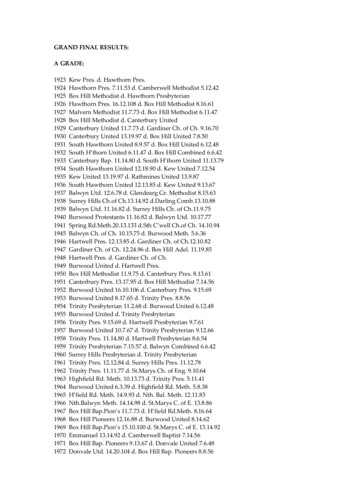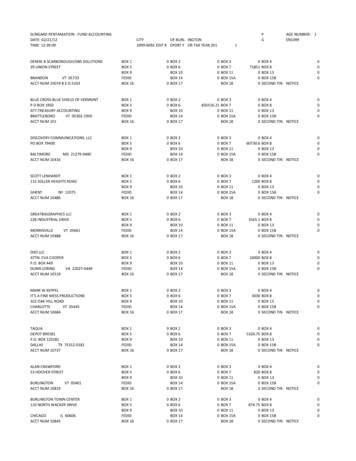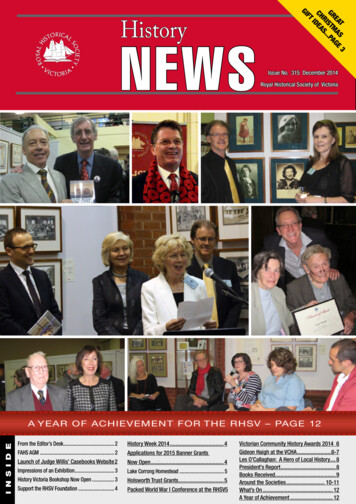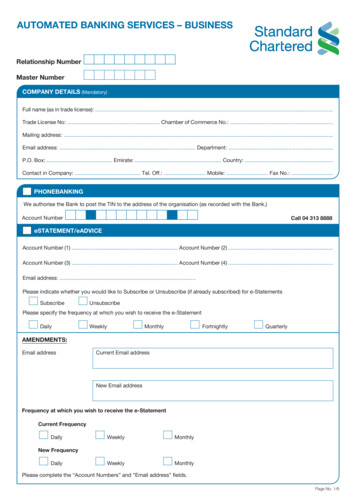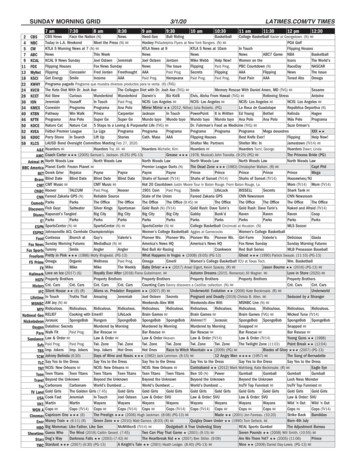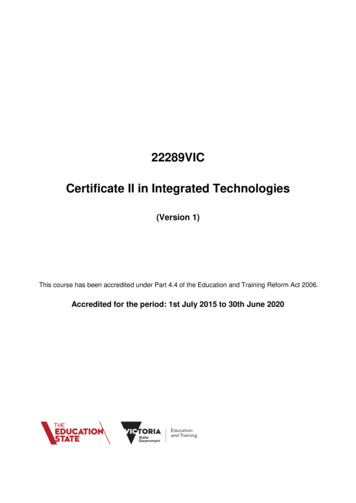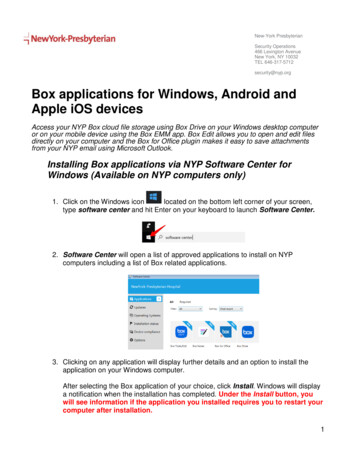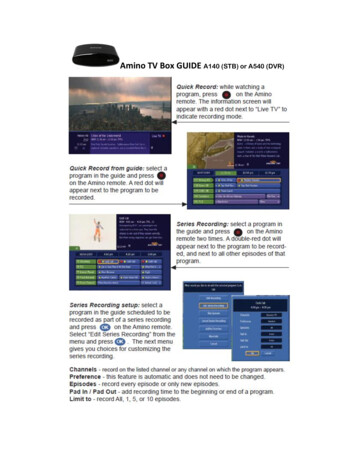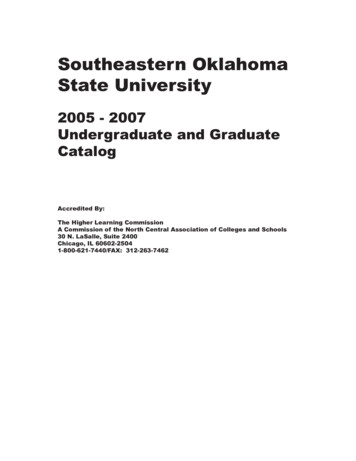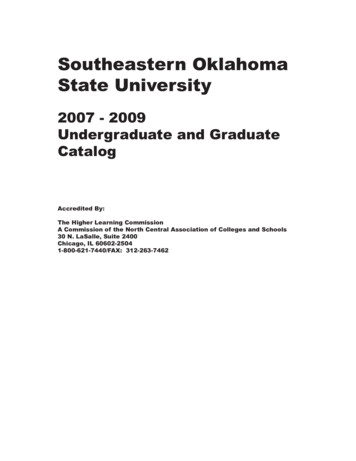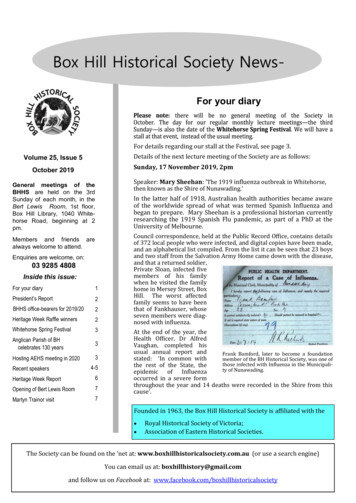
Transcription
Box Hill Historical Society NewsFor your diaryFor details regarding our stall at the Festival, see page 3.Details of the next lecture meeting of the Society are as follows:Volume 25, Issue 5Sunday, 17 November 2019, 2pmOctober 2019Speaker: Mary Sheehan: ’The 1919 influenza outbreak in Whitehorse,then known as the Shire of Nunawading.’General meetings of theBHHS are held on the 3rdSunday of each month, in theBert Lewis Room, 1st floor,Box Hill Library, 1040 Whitehorse Road, beginning at 2pm.Members and friends arealways welcome to attend.Enquiries are welcome, on:03 9285 4808Inside this issue:For your diary1President’s Report2BHHS office-bearers for 2019/202Heritage Week Raffle winners2Whitehorse Spring Festival3Anglican Parish of BHcelebrates 130 years3Hosting AEHS meeting in 202034-5Recent speakersHeritage Week Report6Opening of Bert Lewis Room7Martyn Trainor visit7In the latter half of 1918, Australian health authorities became awareof the worldwide spread of what was termed Spanish Influenza andbegan to prepare. Mary Sheehan is a professional historian currentlyresearching the 1919 Spanish Flu pandemic, as part of a PhD at theUniversity of Melbourne.Council correspondence, held at the Public Record Office, contains detailsof 372 local people who were infected, and digital copies have been made,and an alphabetical list compiled. From the list it can be seen that 23 boysand two staff from the Salvation Army Home came down with the disease,and that a returned soldier,Private Sloan, infected fivemembers of his familywhen he visited the familyhome in Mersey Street, BoxHill. The worst affectedfamily seems to have beenthat of Fankhauser, whoseseven members were diagnosed with influenza.At the end of the year, theHealth Officer, Dr AlfredVaughan, completed hisusual annual report andFrank Bamford, later to become a foundationstated: ‘In common withmember of the BH Historical Society, was one ofthose infected with Influenza in the Municipalithe rest of the State, thety of Nunawading.epidemic of Influenzaoccurred in a severe formthroughout the year and 14 deaths were recorded in the Shire from thiscause’.Founded in 1963, the Box Hill Historical Society is affiliated with the Royal Historical Society of Victoria;Association of Eastern Historical Societies.The Society can be found on the ’net at: www.boxhillhistoricalsociety.com.au (or use a search engine)You can email us at: boxhillhistory@gmail.comand follow us on Facebook at: www.facebook.com/boxhillhistoricalsociety
President’s report – October 2019Suggestions?Since my most recent report, the Society has continued to be activelyinvolved in collecting, collating, archiving and displaying aspects ofBox Hill’s history. As well as the regular lecture meetings, we havebeen successfully engaged in Heritage Week, undertaking a range ofactivities. Details of these events can be found in this Newsletter. Also of note, and detailed elsewhere in this Newsletter, are a couple ofoccurrences involving the Society — the renaming of Meeting Room 1in the Box Hill Library; and the visit of a couple from South Africawith a long-standing connection to Box Hill.The monthly meetings of both August and September were well attended. In August we were enthralled by Ian Broadhead telling thestory of more than a century of his family’s involvement in local affairs. In September, as part of the Society’s contribution to the themeof this year’s Whitehorse Heritage Week, Dr Ed Brentnall related hisexperiences of setting up Australia’s first Emergency Department, atBox Hill Hospital.The Committee welcomessuggestions from members forevents to be held by the Box HillHistorical Society.Gary PreslandPresidentBHHS office-bearers for 2019/20At the Annual General Meeting, held on 18 August 2019, thefollowing members of the Society were elected to thenominated positions on Committee, as r:Dr Gary PreslandWilliam OrangeHelen Harris OAMJohn BarnaoCommittee members:Ian BroadheadJudith EadonRev Shane HubnerRic PawseyGrace SwineyThe Society congratulates the following lucky prize winners in its fundraising raffle, drawn after the meeting on Sunday 15 September.( 50 Bunnings Gift Card)(Copy of The Place for a village; RRP 40)( 30 Coles–Myer gift card )(Bottle of wine, 20)Tony De FazioEmma StirkJudith EadonMichelle MountainBox Hill Historical Society is pleased to thank its sponsors,Bunnings Warehouse, Box Hill South, and Coles, Box Hill.Page 2Mission StatementThe Box Hill Histori calSociety seeks to collect,preserve, facilitate access, research and communicate itemsthat reflect life in and the development of Box Hill and district.Geographical area of interestThe Collection is relevant to thesuburbs of Box Hill, Box HillNorth, Box Hill South, Mont Albert, Mont Albert North, Bennettswood and the parts of Burwood and Surrey Hills, which fallwithin the City of Whitehorse.New membersHeritage Week Raffle winners1st2nd3rd4thIf you have any ideas for topicsfor talks or speakers, tours, orexhibition topics, please contacta member of the Committee.Box Hill Historical Society Newsletter, vol. 25, no. 5The Committee is pleased towelcome the following individualswho have joined the Society inrecent months (With apologiesfor the delay.) We hope theirassociation with the Society is along and beneficial one.Kevin Earl;Yvonne Fitzmaurice;Ruth Hoskin;Paul Jackson;Dianne O’Leary;Lesley and Kevin Peowrie;Glenda Ruggeri;Betty and Ken Walters;
Other forthcoming eventsWhitehorse Spring Festival, 20 October 2019As we catch our collective breaths following the heightenedactivity of Heritage Week, we are gearing up for this year’sSpring Festival. The Society will be conducting its usual stall, atwhich we will present to the pubic some aspects of our work.The theme of the Festival this year is STEM (Science,Technology, Engineering and Maths) .Volunteers are needed to staff the Society’s stall, as well asthe second-hand book table. The operating hours for thefestival are 10 am to 4 pm, and we need to have three peopleon hand in each of the three shifts: 10–12; 12–2; and 2–4. Ifyou can spare a couple of hours in the afternoon, pleasecontact Helen on 0429 833 324, or Gary on 0416 316 419.Anglican Parish of Box Hill celebrates 130 yearsThe weekend of 26/27 October 2019 will be a special one ofcelebrations for the community at St Peter’s Box Hill, as theycelebrate 130 years! The hall will be open on the Saturdayfrom 9am to 2pm and filled with historic displays of theparish and the local area. The church will be open andguided tours available, explaining the meaning and historybehind many of the interior decorations and fittings of StPeter’s Anglican Church. Morning tea will be available for asmall charge and there will be an opportunity to have a ridein a vintage car. For further details please ring the parishoffice on 9890 5122 or the vicar on 0432 681177.BHHS digitising projectThanks to the Trivia Night and raffle and anumber of personal donations maderecently, the Society’s efforts to raise thesum required for this project have received asignificant fillip. The Committee is pleased toacknowledge the following contributionsmade to the Society’s project to digitiseissues of the Box Hill Reporter, and to thankthe individuals, as listed below, for theirdonation. Trivia Night & Raffle10242nd hand book sales60Name withheld by request500Janet Galley15Lorraine Taylor20Martin Trainor100Margaret Wood50Progress will be reported in successivenewsletters, in the graphic form aspresented here: 4620BHHS to host February 2020 AEHS meetingThe Association of Eastern Historical Societies has acceptedBHHS Committee’s offer to host the first meeting in 2020 offellow members of the Association. This event will takeplace on Saturday, 22 February 2020. The host Societyprovides a guest speaker, and in this case it will be oursecretary Helen Harris OAM, who will speak on the history ofwomen in local government. Thiswill be a timely topic, as next yearmarks the centenary of election ofthe first woman Councillor, inNovember 1920. Helen, a formerCouncillorherself, iswellqualified to speak on the subject,having extensively researched it,and as the author of The right tovote; the right to stand.Further details of the event willbe forthcoming nearer the date.Page 3Box Hill Historical Society Newsletter, vol. 25, no. 5 2280(Not to scale)Volume
Recent speakersWilliam R. OrangeLocal resident and Society member Ian Broadhead’s talk to the August general meeting marked aCentury of the Broadhead family in Box Hill. The audience included family and friends of the Broadheads, among them former councillor Dennis Trewhella. Ian Broadhead’s grandfather Percy Broadheademigrated with his family to Australia from the U.K. in 1911. The family settled in Ascot Vale when George,Percy’s father found work with the Victorian Railways. Percy obtained a full time job with a milk companyand undertook part time accountancy studies. He was also a member of the YMCA and church groups.Percy enlisted in the army in 1916 and married in 1917. After Percy returned from two years’ war service they moved to Mersey Street in Box Hill and he resumed work at the Bacchus Marsh Milk Company.An application for a job with the shire council was unsuccessful but in 1921 he obtained a position withHudson and Keen, initially as a ledger clerk, then as manager of their electrical store at 974 WhitehorseRoad. He was a founding member of Box Hill RSL (their first clubrooms was an octagonal brick buildingin the centre median plantation opposite Box Hill Town Hall); he also served on the committee to construct the Shire War Memorial in Station Street. Percy and his wife Everina were on the Box Hill StateSchool parents’ committee working with the Kingsley family and other local traders to provide food forthe undernourished children attending the school.In 1936 the Broadheads purchased and moved to 1 Elland Avenue. A couple of years later Percy leftHudson & Keen and established P. Broadhead & Son at 31 Carrington Road as a facilitator and supplierto the building trades. The early war year of 1939 was a financially challenging one for the family andthey survived with the support of elder daughter Eve. Their son (and Ian’s father) Alan attended Box HillState School and Box Hill High School before obtaining job as a draughtsman for the MMBW. Next camea position at the Bank of Australasia’s Brunswick branch, followed by a transfer to Leongatha where hemet and married his wife Sheila. 1942 saw Alan enlisting in the army: after initial training he attendedOfficer Training School in Albury then Woodville, South Australia before jungle training at Canungra inQueensland. After service in Bougainville and the Pacific he returned to Australia in 1946, resuming employment with the bank (now part of ANZ) and playing football with Box Hill, who were Premiers thatyear. When Percy’s health began declining in 1947/48 Alan resigned from the ANZ and joined the business. A cousin, Arthur Broadhead, Henry Yeomans (from Birds’ Timber Yard) and Perc Newton (Myer’s)followed, as P. Broadhead & Son expanded during the early 50s. Prior to his death in 1952 Percy hadacquired the corner block opposite Box Hill Baptist Church. A new store was built in 1955 and in 1956the business relocated there from 31 Carrington Road: all the family and friends helped with the move.The business became supplier to many Box Hill tradesmen, including the builders of the Latter DaySaints’ Church in Blackburn.Post-war, Alan and Sheila's transport was a BSA motorcycle and sidecar. They also enjoyed playingtennis with Box Hill Tennis Club in Shipley Street. In 1948 they purchased a block of land at 17 WattsStreet and built a house, into which the family moved in mid-1950. They were adjacent to worldrenowned rosarian T.A. Stewart at 19–23 Watts Street (now a block of flats). By 1951 Alan had upgraded his transport to a Ford Customline utility and the Lawn Bowls Club rooms to the south in WattsStreet were relocated to a new green in Poplar Street on the corner of Whitehorse Road.As Box Hill developed, Traders’ Associations were formed; in the 1930s an earlier group attempted tohave the railway crossing at Box Hill lowered. During the 1950s a Chamber of Commerce was formed:all the businesses were owner-operated (Hoath, McLaughlin, Weston, Cleghorn et al.) and worked together to run the Whitehorse Festival. It included a parade of floats and performing groups—and on oneoccasion ‘Lady Godiva’ on a white horse—that progressed from Carrington Road to the White Horsemonument, with the horse and rider continuing on and into the Box Hill Town Hall to participate in anepisode of Channel 7’s ‘Sunny Side Up’.The 1950s saw school populations rising, youth clubs evolving, Scout and Guide groups thriving (Alanwas District Commissioner for a period) and service clubs emerging. Alan joined Rotary in 1956 andwas chairman of a fundraising committee for the 1960 Olympics. He stood for and was elected to Council with Ron Cleghorn in 1964, was Mayor in 1967/68 and a regular participant in school investituresand community events. Retail business was changing with chain stores and regional shopping centres.Page 4Box Hill Historical Society Newsletter, vol. 25, no. 5
Recent speakers, continuedWilliam R. OrangeOther changes included decimal currency, metric conversion, credit cards and extended trading hours(1971). The tram extension to Box Hill consolidated Box Hill as a transport hub with even more development of larger enterprises, and an Asian food centre. One suggestion for the influx of Hong Kong money hasbeen that a location on a hill is seen by these entrepreneurs as prestigious, and Box Hill is ‘on a hill’.In 1974 Broadheads’ hardware amalgamated with Frank Jeffrey’s timber business to form J.M. BroadheadHardware and Timber and relocate to Jeffrey’s Thames Street corner site. Frank Jeffrey later sold out to Arthur who then became Alan’s partner. In 1987 they sold the business to Graeme Dernelly: by the early2000s the business was closed and the site sold for the construction of apartments.Retired physician and former local resident Ed Brentnall OAM spoke to the September general meeting about the History of Emergency Medicine at Box Hill Hospital and beyond. The audience includedfamily and his nurse colleague Noelle Pink who was his original Triage nurse.Ed Brentnall graduated in Medicine in the U.K. in 1952. After two six-month hospital placements in Paediatrics and Geriatrics he went on to do three years National Service in the RAMC as a medical officer to British troops based mainly in Singapore. On return to the U.K. he did some obstetrics work, followed by general practice in Kent from 1958 until he and his family emigrated to Australia in 1965. In 1966 Brentnalltook up a position with the Whitehorse Medical Group in Box Hill where Harry Judkins was the senior partner and a promoter for the construction of Box Hill Hospital, which had opened in 1956. By 1966 hospitalbeds, in particular those for obstetric patients, were in short supply so some births took place at Bethesdain Richmond.Peter Bush, a Blackburn GP recruited him to join St. John Ambulance in 1967; initially he was surgeon to theWaverley St. John’s Cadets, and later a Commissioner. Bush became Director of Emergency at RMH in 1973.After nearly 10 years Brentnall became unsettled working in general practice. Through Alan Davis at Box HillHospital he heard that the position of Director of Casualty at the Hospital was available – no special trainingrequired. After consulting with his wife he applied, was successful and took up the position in July 1975.Medicare had not long been implemented and Emergency, for which there had been a means-testedcharge became free. The staffing was lamentable and attendance had tripled in 10 years to about 40,000per year. Basic staffing was five 1st year interns to cover 24 hours per day with two residents on call; twosessional GPs; and five sessional surgeons. They were a mixed bunch and the surgeons were really onlyinterested in major trauma or illness.He took the long service leave owing to him from the medical practice in 1976 and travelled to the U.K.and Europe, including visits to five English Accident and Emergency Departments. Leeds was remarkable,especially for its orthopaedic surgeon who was highly skilled in hand surgery, and an excellent follow-upprogram that included physiotherapy and rehabilitation. On return home he prepared a report for thehospital board, recommending a new expanded accident and emergency department and noting that thehospital was too small and had too few staff to carry out its existing workload. The proposal to concentrateon the A & E department was declined.In March 1976 a triage system was introduced (it had been first come, first seen). Some patients requiredimmediate attention; others who were ‘fairly urgent’ could be left in the queue. Priority was given to theurgent rather that the important. Triage was used at the Battle of Waterloo where the fixable were retrieved and the walking wounded evacuated themselves. At Box Hill, an experienced nurse was placed atadmission to classify patients initially into three categories – Yellow (clearly urgent), Blue (definite injuries)and White (others). This evolved into five categories – Signal one (most urgent) Orange, then Yellow, Blue,Green and White. Box Hill Hospital was the first hospital in Australia to introduce a formal triage system,followed by Ipswich five years later. It changed the way hospital emergency departments worked, hasspread widely and is accepted internationally.A study of patients arriving at Emergency at the time and the catchment area from where they came foundthat Box Hill Hospital was serving a population of 630,000 (23% of Melbourne) and had 206 beds (5.5% of(concluded on page 6)Page 5Box Hill Historical Society Newsletter, vol. 25, no. 5
Recent speakers, concludedMelbourne public hospital beds). At the time there was no hospitals at Maroondah or Monash and theAustin was difficult to access. The new Box Hill Hospital has 600 beds and an excellent emergency department.Box Hill has become a major recruiter for interns, moving from general to emergency medicine, with many becoming outstanding emergency physicians. Ed Brentnall initially restructured the department to engageexperienced third-year doctors, then other keen and enthusiastic staff, and had sessional staff phased out.In 1979 he travelled to the USA on sabbatical leave and visited the trauma centre at Maryland, Baltimore.They had developed a team approach to major trauma, comprising a senior doctor and nurse and severalothers with designated roles including a ‘recording angel’ to document all procedures. This system wasformally adopted in 1983 at Box Hill for major trauma. Box Hill by then had become a major trauma centre– in 1980, 800 samples for blood analysis were taken from motor vehicle accident patients.The Victorian Emergency Department Association was formed to assist the sharing of skill and information amongst nurses and doctors. In 1983 the Australian College of Emergency Medicine (ACEM) wasformed and in 1993 Emergency Medicine was recognised as a specialty. Box Hill Hospital has been a majorcontributor to the development of emergency medicine, informing academic structure, teaching and recognition of the specialty. (Simon Judkins, grandson of Harry is the current president of the ACEM.)Heritage Week ReportThe theme of this year’s Whitehorse Heritage Week (12–19 September) was Health & Wellbeing. This was inkeeping with 2019 being the centenary of the outbreak of the Spanish flu pandemic. In preparation for theweek, the Archivist and her volunteers investigated surviving records, and compiled a listing of every localperson who became infected. She also located details of people who caught other infectious diseases, andcompiled an index of these people, covering the period 1914 to 1926. Eventually, both of these indexes willbe uploaded to our website, but in the meantime will be on display at our stall at the Spring FestivalIn addition, a range of activities wereconducted by the Society during HeritageWeek, all based on the theme of health.These events included a bus tour of significant sites in the story of health management in the Box Hill area; a walkingtour of Box Hill cemetery, titled Medicosand misadventures (both undertaken inconjunction with Surrey Hills HistoricalSociety); a two-day display in the lowertown hall, which included several talkson relevant topics; and a Trivia Night onthe theme ‘What’s up, Doc?’. Our round ofactivities concluded with our regularmeeting, on Sunday 15 September, atwhich Dr Ed Brentnall MBE OAM spokeon the history of emergency medicine atBox Hill Hospital.Some of the participants in the bus tour, pictured at Hethersett House, (L–R)Helen Harris OAM; Jane Dyer; William Orange; Margaret Wood; Ian Wood;Alison Dews. Photograph courtesy of Sue Barnett.Page 6Box Hill Historical Society Newsletter, vol. 25, no. 5
Official opening of the Bert Lewis RoomThe Society was well represented at the official opening of the Bert Lewis room on September 4.The change in name of our usualmeeting venue in Box Hill Librarywas an initiative of this Society, suggested as a way of acknowledgingand commemorating the work offormer Head Librarian and community activist, Herbert Lewis. The BertLewis Room was officially opened byCouncillor Tina Liu. A presentationwas made by the President in which hebriefly detailed the activism of MrLewis. This was followed by a shortbut very interesting talk by StuartKells, in which he spoke about hisPictured at the opening of the Bert Lewis Room are (L–R): BHHS President DrGary Presland; Cr Tina Liu; author Stuart Kells; and Whitehorse Manninghamworldwide travels visiting libraries.Chief Librarian Sally Both. Photograph courtesy of Whitehorse Library staff.Stuart is the author of a recently publishedbooktitledTheLibrary: a Catalogue of Wonders.Visit by Martyn TrainorL–R: Dr Paul Fox; Martyn Trainor; Yolande Trainor; Whitehorse Mayor CrBill Bennett; BHHS Secretary Helen Harris OAM; BHHS President Dr GaryPresland, pictured in front of the eponymous white horse.On 8 August, the BHHS Committee waspleased to host a visit to our premisesby Martyn Trainor and his wifeYolande, from South Africa. Martyn isa descendant of Patrick Trainor, firstowner of the Whitehorse Hotel. In BoxHill they were accompanied by PaulFox, a local resident and noted historian, and a Trainor descendant also.They were welcomed at a small ceremony in the Whitehorse Art Space, byBHHS President Gary Presland, andhad a tour of the Heritage Centre andTown Hall.Martyn expressed their pleasure at being in the area and commended the good work of the Society inhelping to maintain the memory of his ancestor. Martyn and Yolande later kindly made a donation towards the digitisation project.Page 7Box Hill Historical Society Newsletter, vol. 25, no. 5
Box Hill Historical Society Inc.No. A15258VABN 613 34916140Heritage Centre – 03 9285 4808Suite 7, 27 Bank Street, Box Hill.(Town Hall Hub, rear Box Hill Town Hall)Hours: 11–4, Tuesdays; otherwise, by appointmentEDI TORDr Gary PreslandPhone: 03 9890 9288President: Dr Gary PreslandVice-President: William OrangeSecretary: Helen Harris OAMTreasurer: John BarnaoCommittee: Ian Broadhead, Judith Eadon,Rev. Shane Hübner, Ric Pawsey, Grace SwineyBox Hill HistoricalSocietyNewsletterPO Box 268 Box Hill 3128Box Hill Historical Society gratefully acknowledges the Cityof Whitehorse for its support with grants, discounts on hallhire, concessional use of premises in the Box Hill TownHall and its willing assistance with our exhibitions in theBox Hill Town Hall Art Space.
Percy ïs father found work with the Victorian Railways. Percy obtained a full time job with a milk company and undertook part time accountancy studies. He was also a member of the YMCA and church groups. Percy enlisted in the army in 1916 and married in 1917. After Percy returned from two years war ser-
